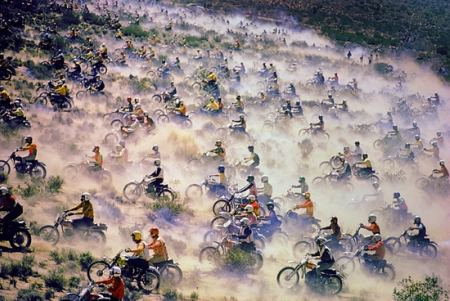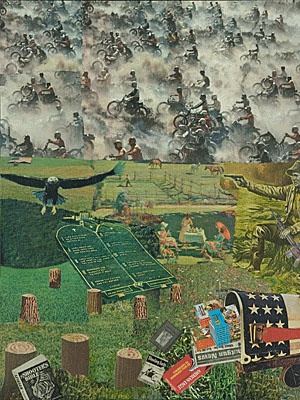If a writer inserts a couple of paragraphs written by someone else into an essay without attribution, the end result is not called a collage. If an artist does the equivalent, it is. Art is an omnivore. It will eat anything. The law calls the practice fair use, although the protection the term implies exists only on a case-by-case basis. Since the 1980s, the art world has called it appropriation. The practice predates the movement by a century: It’s hard to imagine Modernism without it.
Even so, Bill Eppridge‘s outrage is understandable. (Via C-Monster)
Eppridge, Barstow to Vegas Motorcycle Race, 1971
 Seattle’s Deborah Faye Lawrence, The Mysterious Allure of Rural America, 2008
Seattle’s Deborah Faye Lawrence, The Mysterious Allure of Rural America, 2008
 Undeniable, from Eppridge:
Undeniable, from Eppridge:
The artist used my work to make her collaged work look better.
Debatable:
I risked my life many times to make photographs — in this case I was
standing on the skid outside a helicopter at 500 feet. Seeing my work
stolen in this manner just flat-out offends me because the artist used
something that she didn’t earn or create for her own benefit.
That’s cowboy logic. It’s true that you can’t rope a steer from your desk, but you can make powerful art without breaking a sweat.
Back to undeniable: Great image, Mr. Eppridge.



Interesting that her image looks crowded and his doesn’t. Neither has any empty space, and hers looks like the inside of a junk closet and his is a unified field. She junked up his work. It makes sense because of her contempt for rural America. What if his politics aren’t hers? That would piss him off some more. I know this is OK by art world standards, but it doesn’t feel OK.
This is a direct lift of another person’s work. However, it isn’t quite as tacky as the female photographer who photographs framed photos made by more famous photographers, and calls her work…her interpretation of that person’s work.(!)
(Is this the land of opportunity, or what?!!!)
The laws to protect artists work is way behind.
An essay which uses another persons ideas and language to make a point has one purpose, and that is to convey an idea. If one steals the idea then one has brought nothing to the table. The same goes for a collage. I’m all for found imagery but this is done poorly. Unless the purpose of their art is to infuriate other artists. If that is the case then I kind of like it.
The principal and creative device of Fair Use allows and encourages visual quotation. The question is whether Lawrence’s inclusion of a section of Eppridge’s work in this piece harms Eppridge’s reputation and future income.
Is the reproduced image the same as the print edition? Collage artists use reproductions of original works. In Lawrence’s work, one often sees the screen dots from the offset or laserprint printer process.
Artists use images – visual and verbal – for diverse ends. Bob Rauschenberg and Andy Warhol both literally transferred New York Times and NY Post photos and headlines to their canvases. Artists also use sources outside their generative control. Did Eppridge get model releases from the motorcyclists or permission of the Barstow to Vegas race organizers to create the image of the event?
Go creative freedom!
If I hadn’t seen his work first, I would have assumed at first glance that Lawrence’s motorcycle image was created by cloning in Photoshop.
Lawrence makes effective use of Eppridge’s nearly forty-year-old image and indeed presents it as iconic and representative, while changing its form significantly (shifting the color, selecting a detail). The work is frank about its status as collage, the very definition of which, as you suggest, requires the reuse of existing materials. There’s no question of her attempting to pass off another artist’s work as her own. Eppridge’s emotional reaction may perhaps be understandable, but (unless we are prepared to reject collage as a legitimate art form) there’s no reason for anyone else to adopt his resentment.
I agree with Helen Lessick’s comment.
I definitely owe part of my visual education to the fact that I was able to appropriate+manipulate imagery. Thus, I have started licensing some of my imagery under a Creative Commons license. I would be more than willing to work with people wishing to use my work in other artistic endeavors.
You’re saying the photo is 40 years old and the photographer is upset to see it surface in a collage? If I’d taken it, I’d be happy that Deborah remembered it and used it again. I’d be thrilled if my art were not forgotten.
Regina,
When artists ‘appropriate’ the work of others to create something ‘new’ there is always controversy, and you are right to say that fair use is really a case-by-case basis.
Jeff Koons was successfully sued for ‘appropriating’ a photograph of two people holding a group of puppies and turning it into sculpture. Andy Warhol’s estate was successfully sued for ‘appropriating’ a photograph of Jacqueline Kennedy marching in her husband’s funeral procession and using that photo in a silkscreen. Bill is not going to sue the artist, and it would be up to Time Inc. to pursue that since Bill was on staff at Life magazine when he made that photograph. (fyi:Life had permission from the race organizers to photograph the race, and the photograph was used in a magazine – an editorial use which did not require model releases from any of the participants. The photograph is also widely sold as a poster through art.com, allposters.com, etc, but Bill has no control over that because Time Inc. owns the rights. The photograph is not ‘forgotten’ as one commenter stated.)
However, I don’t believe that the term ‘cowboy logic’ accurately describes what Bill said – I know that from my own experience of working with photographers for more than twenty years. The amount of planning and creativity that is involved with making (and not just ‘taking’) a photograph like the Barstow to Vegas race is hard to understand unless you have spent time working on these projects. Bill has risked his life many times in the pursuit of the image, and the art. What he does, and what many photographers do is art. And, for a certain type of photography, putting one’s life on the line is required in order to make that image – in a helicopter the photographer is at the mercy of the pilot and the equipment. Anything could happen.
Just for the sake of argument, in situations where Bill did not’break a sweat’ there was still an inordinate amount of planning and creativity that went into making memorable photographs. Even in cases where the photographer will tell you that he or she ‘got lucky’ there is something about the best photographers that prepares them for the ‘lucky’ opportunity that most others would have missed. Years of training and experience contribute to being able to catch the right moment just as a painter, or collagist could say that their training and experience enable them to create their art.
Photography is too often dismissed as something that is easy to create. Deborah Faye Lawrence didn’t earn the right to use that photograph, and she didn’t use it very well.
(full disclosure: my husband is Bill Eppridge, and I am a picture editor, and curator. I graduated from Pratt Institute, the art school, so I know both sides of this discussion. I have even created collages, although without appropriating art from someone else.)
I agree with Anita.
And am remembering an article on
the blog of innoncence that included Cory Doctorow’s thoughts…
“I believe that from the artist’s perspective, today’s art must presuppose copying. If you are making art that you expect people not to copy, then you are not making contemporary art.”
Would the reaction have been the same if the work had been at Rauschenberg’s level or attributed to him?
By Anita on January 14, 2010 11:52 PM
You’re saying the photo is 40 years old and the photographer is upset to see it surface in a collage? If I’d taken it, I’d be happy that Deborah remembered it and used it again. I’d be thrilled if my art were not forgotten.
What I find so interesting about the discussion of ‘appropriation’ by artists is the lack of understanding, or appreciation of the basics of copyright, and theft of intellectual property.
Many famous artists have been successfully sued for copyright infringement because of their appropriations. There is much information available to document this, and no artist should claim ignorance on this subject.
If I re-photographed Ms. Lawrence’s collage and then printed it out and sold it as my own work, I wonder what the reaction would be.
Re: Lavalle’s comments about Rauschenberg:
Rauschenberg was successfully sued in 1980 for copyright infringement by famous photographer Pete Turner. Rauschenberg then changed his practices and began to use his own photographs in his works. (fyi: He had studied photography in the 1950s alongside Harry Callahan and Aaron Siskind at Black Mountain College, and had considered becoming a photographer.)
This is a very interesting discussion. The collage is not an “original” art form if a substantial portion of the collage is derived directly from another source. In this case one of Eppridge’s photos. I find the use of the term “visual quotation” confusing in terms of the doctrine of Fair Use.
How can it be fair or accurate or a visual quotation when the use of the photograph is assumed without the attribution that the use of actual quotation marks, as in the case of a print quote, implies.
“Visual quotation”, please, give me a break.